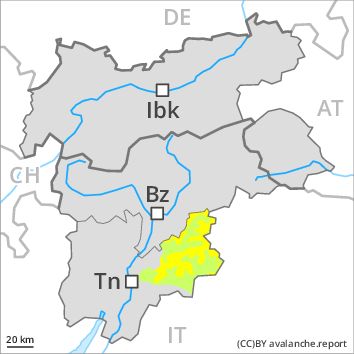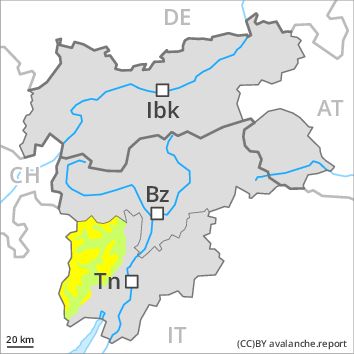Regions
Primiero - Pale di S. Martino, Fassa Valley, Southern Lagorai, Northern Lagorai, Latemar, Pine' - Mocheni Valley

Danger level
Danger Level 2 - Moderate above the treeline
Danger Level 1 - Low above the treeline
Avalanche Problem
Persistent weak layer above 2200m, N-NE-NW
Wet snow above 2400m, N-NE-E-SE-S-SW-W-NW

Weak layers in the old snowpack necessitate caution.
Over a wide area 15 cm of snow, and even more in some localities, fell above approximately 1200 m. It must be evaluated with care and prudence in particular on steep shady slopes. Weak layers exist in the snowpack in particular on steep northeast, north and northwest facing slopes. They can be released in isolated cases, but mostly only by large additional loads, in high Alpine regions. This applies especially above approximately 2400 m and adjacent to ridgelines. These avalanche prone locations are difficult to recognise. As a consequence of warming during the day and the solar radiation, the likelihood of loose snow avalanches being released will increase gradually in particular on rocky slopes at intermediate altitudes. Moist avalanches can in very isolated cases be triggered in the old snowpack and reach medium size especially on steep shady slopes.
Snowpack
In some places fresh snow and wind slabs are lying on a moist old snowpack. The older wind slabs have bonded well with the old snowpack. In very isolated cases weak layers exist in the old snowpack on shady slopes, in particular on shady slopes above approximately 2400 m. At low altitude a little snow is lying.
Tendency
Gradual increase in danger of moist and wet avalanches as a consequence of warming.
Regions
Prealps, Cembra Valley, Bondone and Stivo, Vallarsa, Western Nonsberg Alps, Folgaria - Laverone, Ledro Valley, Paganella, Marzola - Valsugana

Danger level
Danger Level 2 - Moderate above the treeline
Danger Level 1 - Low above the treeline
Avalanche Problem
Wet snow, N-NE-E-SE-S-SW-W-NW
Persistent weak layer above 2000m, N-NE-NW

In steep rocky terrain individual natural avalanches are possible as the day progresses, but they will be mostly small.
Gradual increase in danger of dry and wet avalanches as a consequence of solar radiation. Mostly small natural avalanches are possible in particular in steep rocky terrain. Weak layers in the old snowpack can be released by large additional loads in particular on steep north facing slopes. This applies in particular on shady slopes at high altitudes and in high Alpine regions.
Snowpack
Fresh snow and wind slabs are lying on a wet old snowpack. In some places fresh snow is lying on old snow containing large grains. This applies in particular on shady slopes at high altitudes and in high Alpine regions. At low altitude no snow is lying on south facing slopes.
Tendency
Gradual increase in danger of moist and wet avalanches as a consequence of warming.
Regions
Southern Adamello, Adamello - Presanella, Northern Brenta - Peller, Southern Brenta, Sole, Pejo and Rabbi, Maddalene

Danger level
Danger Level 2 - Moderate above the treeline
Danger Level 1 - Low above the treeline
Avalanche Problem
Wind-drifted snow above 2200m, N-NE-E-NW
Wet snow above 2200m, N-NE-E-SE-S-SW-W-NW

The fresh wind slabs have formed in particular in the vicinity of peaks. Weak layers in the old snowpack necessitate caution.
As a consequence of a sometimes moderate southwesterly wind, small wind slabs formed on Saturday. Especially in the northwest 30 cm of snow. fell above approximately 1200 m. Caution is to be exercised adjacent to ridgelines and in gullies and bowls. These avalanche prone locations are clearly recognisable to the trained eye. Mostly the avalanches are rather small but in some cases easily released.
As a consequence of warming during the day and the solar radiation, the likelihood of loose snow avalanches being released will increase gradually in particular on rocky slopes at intermediate altitudes. Weak layers exist in the snowpack in particular on steep northeast, north and northwest facing slopes. Moist avalanches can in very isolated cases be triggered in the old snowpack and reach medium size especially on steep shady slopes. They can be released in isolated cases, but mostly only by large additional loads, in high Alpine regions. This applies especially above approximately 2400 m and adjacent to ridgelines. These avalanche prone locations are difficult to recognise.
Snowpack
The more recent wind slabs are to be found especially adjacent to ridgelines and in pass areas and generally in the high Alpine regions. At intermediate altitudes the snow is wet. In very isolated cases weak layers exist in the old snowpack in particular on west, north and northeast facing slopes. Outgoing longwave radiation during the night will be quite good over a wide area. The surface of the snowpack will soften during the day.
Tendency
The weather will be mild. Gradual increase in danger of moist and wet avalanches.



